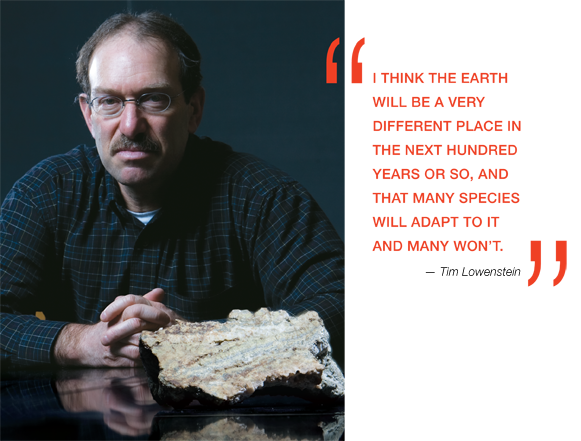page 1 | page 2
Lowenstein and Demicco analyzed nahcolite samples they discovered from drill cores of the Green River Formation taken from deep beneath the surface in the Piceance Creek basin of western Colorado. The samples have been dated back to the Eocene, and Lowenstein says that between 49 and 51 million years ago, the nahcolite crystallized at the surface and dropped to the bottom of salty lake beds, before being buried to its present depth below the surface.
A trona deposit found in Turkey dates back 21 million years, suggesting that somewhere between 50 million years ago and 21 million years ago, atmospheric CO2 levels dropped enough to ensure that trona would become the prevailing sodium carbonate formation, Lowenstein said.
Some of the most important fossil sites for understanding terrestrial plant and animal life of the Eocene Epoch are found in the Green River Formation in western Colorado, eastern Utah and southwestern Wyoming. Fossils found at these sites — and we’re talking flamingos, palm trees and crocodile fossils — indicate that the Eocene climate in Wyoming and Colorado was sub-tropical. “Actually the Eocene climate in Wyoming and Colorado was probably similar to that of the Dead Sea between the West Bank, Jordan and Israel today,” Lowenstein said. During the early Eocene, there was no ice anywhere on the planet, and with higher sea levels, the oceans flooded larger portions of our existing continents.

Besides being a rich fossil repository, the Green River Formation is home to one of the world’s largest oil shale fields and to an enormous sodium carbonate deposit. And the Eocene-aged nahcolite samples recovered from the region point not only to an Eocene climate characterized by Florida-like temperatures in the northwestern United States and Canada, but also to elevated CO2 levels, probably fed by significant ancient volcanic activity, Lowenstein said.
Nahcolite deposits in the Piceance Creek basin of Colorado are up to 300 meters thick and are finely interspersed with halite (sodium chloride, the same as table salt). Since halite also crystallizes under specific, known conditions, its co-existence with the nahcolite anchors minimum early Eocene CO2 levels at between 1,125 ppm and 2,985 ppm for reasonable surface water temperatures of about 20 degrees C to 35 degrees C, Lowenstein said.
That, along with ancient palm tree and crocodile fossils recovered from the same area, suggests that for at least the warmest part of the 20-million-year-long Eocene, mean annual temperatures in Colorado and Wyoming were similar to those measured in Miami today.
Because CO2 is a forcing factor for climate change, increases in its levels can be directly tied to global warming. A greenhouse gas, CO2 absorbs radiation that would normally be reflected out of the atmosphere, helping to ramp up temperatures, melt glaciers and significantly alter ocean currents and weather patterns.
As for steep, projected increases in CO2 levels over the next century, Lowenstein thinks that might not be our only cause for concern.
“The thing I worry about most is that there will be an unexpected change,” he said. “Right now, we’re on a predictable pace. But there will likely be tipping points, unexpected things that could really change things, so all of a sudden we may get changes in ocean circulation that we never would have predicted, or the tundra may melt. Some unexpected thing is going to occur that’s going to be more dramatic than the progressive changes that we foresee.”
As a scientist, Lowenstein has no doubt that burning oil, gas and coal are fueling global warming and creating, along with environmental degradation, an immediate threat to some species of life on the planet. His opinion is unchanged by those who would point to the Earth’s ancient hothouse past as proof that natural swings in climate take place with or without human intervention.
“If we assume that you and I are both in our 50s, the change in atmospheric CO2 in our lifetime is greater than the rate of any change in at least the last half million years,” Lowenstein said.
Global warming experts say that melting of the world’s glaciers, including parts of the Greenland ice sheet and the western Antarctic ice sheet, could well produce a 1-meter (3-foot) rise in sea level in the coming centuries.
With a population of more than 4 million, for instance, the second largest city in Egypt, Alexandria, is just one of the many cities that would be inundated by a rise in sea level of 1 meter. More than 100 million people worldwide live within a meter of the current sea level. One recent study estimated the costs of adapting to even a 1-meter sea-level rise in the United States alone at $156 billion, or 3 percent of the GNP.
Lowenstein said these consequences seem more and more likely without drastic change.
“The glacier on Mount Kilimanjaro has not much time left even now. Many mountain glaciers are going to disappear,” he said.
“It all depends on how much oil we burn. But if we keep doing what we’re doing now, we will be up to the CO2 levels of the Eocene within another 100 or 200 years.”
It is difficult to predict how global temperatures over the coming centuries will compare to the Eocene, but the “hothouse” world 50 million years ago should serve as a reminder of what global changes are possible.
— Susan E. Barker
page 1 | page 2